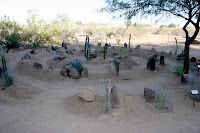 One of my goals in starting this blog was to show the world that this simply isn't true, and the Deer Valley Petroglyph Preserve (formerly the Rock Art Center) is a perfect example of what a rich and diverse place Phoenix really is.
One of my goals in starting this blog was to show the world that this simply isn't true, and the Deer Valley Petroglyph Preserve (formerly the Rock Art Center) is a perfect example of what a rich and diverse place Phoenix really is.The Deer Valley Petroglyph Preserve is a historically and culturally important part of North Phoenix. It is nestled at the base of Hedgpeth Hills in the Adobe Dam Recreation Area, just west of 35th Avenue on Deer Valley Road.
It's also one of the Phoenix Points of Pride and it's on the National Register of Historic Places. The center is operated by Arizona State University and is a member of the Central Arizona Museum Association. Its collection of prehistoric drawings is the largest in the state. In short, the significance of the Rock Art Center is not to be understated.
 It is on this 47-acre preserve site that some of Arizona's earliest residents left their marks in the form of petroglyphs and pictographs. While many of the symbols are still being studied, researchers have identified religious, weather, hunting, and astronomy symbols. Over 1,500 drawings have been catalogued, dating back to approximately AD 500-1200.
It is on this 47-acre preserve site that some of Arizona's earliest residents left their marks in the form of petroglyphs and pictographs. While many of the symbols are still being studied, researchers have identified religious, weather, hunting, and astronomy symbols. Over 1,500 drawings have been catalogued, dating back to approximately AD 500-1200.Of course, the Rock Art Center has much to offer the non-anthropologist as well. The acclaimed architect Will Bruder designed the visitor center and museum, which was completed in 1994. Since then, Bruder has gone on to design the highly-praised Scottsdale Museum of Contemporary Art and the Burton Barr Library on Central Avenue. This humble yet welcoming structure invites exploration, and its rock-covered exterior walls are reminiscent of a crumbling chocolate cake.
The interior contains exhibits and information about the site and the early Hohokam settlers who lived in the area. The high ceilings and muted lighting felt more like visiting a rich friend's home than a stuffy old museum. A troop of young Boy Scouts was listening eagerly to a tour guide in the glass-walled meeting room as I made my way to the trailhead.
 The trail is just 1/4 mile long over flat ground, and it is very well marked. The trail follows the base of Hedgpeth Hills, which are covered with black desert rocks (clearly I am not a geologist, either!). Along the way, there is a small garden where historical crops like corn, beans, and squash are being grown in the traditional Hohokam fashion. A row of grinding stones gives visitors a hands-on way to see what it was like to produce food centuries ago, long before electricity and the Cuisinart machine were invented.
The trail is just 1/4 mile long over flat ground, and it is very well marked. The trail follows the base of Hedgpeth Hills, which are covered with black desert rocks (clearly I am not a geologist, either!). Along the way, there is a small garden where historical crops like corn, beans, and squash are being grown in the traditional Hohokam fashion. A row of grinding stones gives visitors a hands-on way to see what it was like to produce food centuries ago, long before electricity and the Cuisinart machine were invented.The trail ends at an outcrop of rocks which are covered in petroglyphs and pictographs. Climbing on the rocks is forbidden, but the drawings are close enough that a zoom lens or binoculars are not required. A variety of native desert plants such as creosote, mesquite, and palo verde were identified with little signs for the benefit of us non-botanists.
 The walk back to the parking lot takes you over a concrete footbridge, where the unique design of the visitor's center really becomes apparent. The museum is bordered by Hedgpeth Hills on the West and Adobe Dam on the North, and is in fact built over the spillway for the dam. Its boomerang shape contains no right angles and acts as a manmade link between Adobe Dam and the mountain, like a bridge between the past and the present. A long concrete channel directs runoff from Adobe Dam into Skunk Creek below the foundation of the museum, which must be an awesome sight after it rains!
The walk back to the parking lot takes you over a concrete footbridge, where the unique design of the visitor's center really becomes apparent. The museum is bordered by Hedgpeth Hills on the West and Adobe Dam on the North, and is in fact built over the spillway for the dam. Its boomerang shape contains no right angles and acts as a manmade link between Adobe Dam and the mountain, like a bridge between the past and the present. A long concrete channel directs runoff from Adobe Dam into Skunk Creek below the foundation of the museum, which must be an awesome sight after it rains!Whether you're into museums, hiking, desert plants, or ancient civilizations, there's something here for everyone. It's also a great place to soak up the beauty of the natural desert environment away from the noise of the city, without actually leaving the city. From start to finish, the Deer Valley Petroglyph Preserve is truly a hidden gem of North Phoenix.
No comments:
Post a Comment